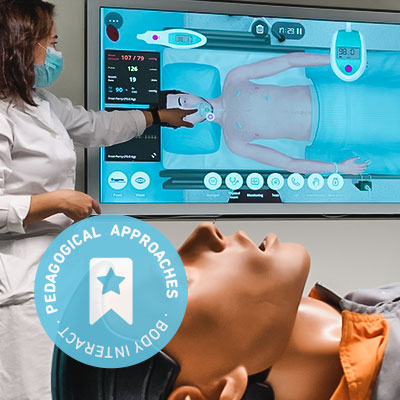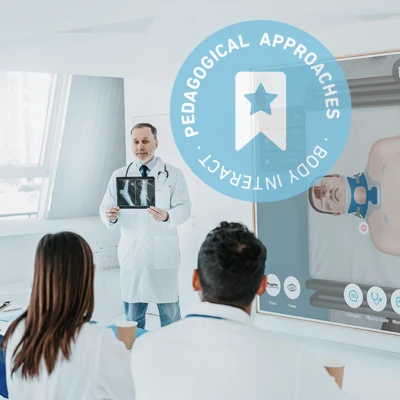What is an Objective Structured Clinical Examination (OSCE)?
It’s a comprehensive and objective method for evaluating clinical competencies and performance within simulated environments, conducted in a standardized manner.
The OSCE’s core principles are objectivity and standardization. This assessment tool evaluates the candidate’s professional performance across a series of time-limited stations, marked against standardized scoring rubrics.
Globally used, OSCEs have some relevant limitations to their implementation, namely: the number of stations required, the number of trained examiners, the development of objective and standardized checklists, the logistics, the budget associated, for example, with facilities, resources, standardized patients, the high demand of resources, the difficulties with human factors standardization and student stress.
What are the OSCE Scenarios of Body Interact?
Body Interact’s OSCE scenarios have been designed to evaluate students’ knowledge and skills relevant to the subject matter of the virtual clinical scenario, for which in key actions performed by the student, questions will be presented.
So far Body Interact scenarios have allowed Professors to teach, train, and assess clinical reasoning, decision-making, problem-solving, and diagnosis skills. With this new feature, Professors can complement the evaluation with relevant knowledge-based questions.

What are the key features and benefits of the OSCES scenarios of Body Interact?
Standardized and Objective Evaluation: Experience a new level of consistency with virtual clinical cases on Body Interact. Every student faces the same clinical scenarios and evaluation items, ensuring a standardized and fair assessment process.
Unbiased Scoring: Body Interact’s automated OSCE sessions provide impartial scoring, guaranteeing fairness in every assessment.
Automated Evaluation: Eliminate the hassle of manual grading. With embedded questions during and after simulations, Body Interact OSCEs automatically and objectively grade students, saving time and ensuring accuracy.
Simultaneous Student Assessment: Maximize efficiency with simultaneous assessments. All students can access and complete the OSCE scenarios independently, without waiting for their turn.
Consistent Virtual Patients: No more variability due to patient fatigue. Every Body Interact Virtual Patient presents the same set of signs and symptoms, ensuring reliable and repeatable clinical encounters.
Extensive Scenario Library: Explore a diverse range of clinical scenarios. From common to rare conditions, across various specialties and settings, Body Interact offers a comprehensive library that covers simple to complex health issues.
Ready-to-Use Evaluation Scenarios: Streamline your OSCE preparation. Body Interact provides fully prepared scenarios with relevant questions embedded within and after the simulation.
Comprehensive Skills Assessment: Evaluate both cognitive and non-clinical skills. OSCE scenarios assess knowledge, decision-making, clinical reasoning, diagnosis, prioritizing, and problem-solving through detailed performance data and simulation outcomes.
Blueprinting for Balanced Evaluation: Achieve targeted assessment goals with ease. Body Interact LMS, the BI Studio, offers all the necessary tools to select cases based on your specific learning objectives and criteria.
Efficient Data Storage and Organization Stay organized with meticulous data management. Collect, store, and organize assessment data seamlessly, including detailed performance metrics and individual grading information, ensuring comprehensive records for every student.
Formative and Summative Assessments: Gain valuable insights into student performance. Body Interact collects data that helps educators conduct both formative and summative assessments, highlighting learning outcomes and pinpointing areas for improvement.
How can OSCE scenarios of Body Interact be integrated into an Evaluation?

One (or more) OSCE Station
A Body Interact OSCE scenario can be seamlessly integrated as one of the stations in a traditional OSCE setup.
Virtual OSCE
Transform traditional OSCEs with digital adaptations. Virtual OSCEs eliminate the need for extensive resources, evaluation checklists, and evaluator training. With Body Interact, you can create a comprehensive multi-station OSCE where all students can participate simultaneously in the same room or remotely.
This flexible, scalable, and cost-effective alternative maintains rigorous assessment standards essential for healthcare education.
Hybrid Assessment
Develop a holistic and comprehensive evaluation targeting different clinical domains using an OSCE scenario as the guiding resource. Assess clinical reasoning and factual knowledge through the virtual patient and integrate the assessment of psychomotor and procedural skills with manikins (e.g., placing an IV into a part-task trainer) or other non-clinical tasks such as preparing patient handoff reports.
OSCE scenarios best practices for evaluation?
- Student preparation: Have Body Interact as a regular pedagogical resource in the curriculum so that students have no doubts when it comes to menus and the flow of the simulation.
- Simultaneously assess all of the students: To ensure no information on the virtual patient is shared between students have them all simultaneously solve the case.
- Use a Blended Approach: Combine virtual patient OSCE scenarios with other assessment methods, such as manikin-based simulations and written exams, to provide a well-rounded evaluation of both clinical and non-clinical skills.

Who is using this evaluation strategy?
Professor Patricia Marín Maicas of the International University of Valencia has integrated Body Interact OSCE scenarios into the Evaluation process of the nursing curriculum, with excellent feedback from the students.

Dive into the future of clinical assessment with Body Interact and transform your OSCE experience! Want to try out the OSCE scenarios?
Contact us!
References
Grover, S., Pandya, M., Ranasinghe, C. et al. Assessing the utility of virtual OSCE sessions as an educational tool: a national pilot study. BMC Med Educ 22, 178 (2022). https://doi.org/10.1186/s12909-022-03248-3
Setrakian J, Gauthier G, Bergeron L, Chamberland M, St-Onge C. Comparison of Assessment by a Virtual Patient and by Clinician-Educators of Medical Students’ History-Taking Skills: Exploratory Descriptive Study. JMIR Med Educ. 2020 Mar 12;6(1):e14428. doi: 10.2196/14428. PMID: 32163036; PMCID: PMC7099396.









